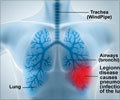
"Sometimes there is a perception, not restricted to pneumonia, that the use of a broad spectrum antibiotic, a big gun, is going to be the best treatment for all patients. This perception can complicate the selection of antibiotics especially when there is limited information to support the decision," said senior author Carlos G. Grijalva, M.D., MPH, assistant professor of Health Policy. "To help inform those decisions, this study compared two pneumonia treatment regimens, a big gun (broad spectrum antibiotics) vs. a small gun (narrow spectrum antibiotics), and found there were no significant differences in clinical outcomes or associated costs."
In Summer 2011, the Pediatric Infectious Diseases Society and Infectious Diseases Society of America (PIDS/IDSA) released joint community-acquired pneumonia guidelines that recommend narrow-spectrum antibiotic therapy for most children hospitalized with pneumonia but, until now, few studies had compared the effectiveness of this strategy relative to use of broad spectrum antibiotics.
Using data from 43 children's hospitals in the U.S., the authors compared outcomes among children 6 months to 18 years of age hospitalized for pneumonia between 2005 and 2011, receiving either ampicillin or penicillin (narrow spectrum) or a third generation cephalosporin (ceftriaxone or cefotaxime,[broad spectrum]). According to the PIDS/IDSA guidelines, both treatment strategies are effective for disease caused by Streptococcus pneumoniae, the most common bacterial cause of pneumonia.
Lead author Derek J. Williams, M.D. MPH, assistant professor of Pediatrics, said doctors worry about increases in unnecessary use of broad spectrum antibiotics because they drive increases in disease caused by antibiotic-resistant bacteria.
"We have seen increases in use of broad spectrum antibiotics and concurrent increases in disease caused by resistant bacteria. For this study, we hypothesized that narrow and broad-spectrum antibiotics would have similar effectiveness in the treatment of childhood pneumonia. Our findings support the preferential use of narrow spectrum antibiotics as first-line therapies for most children hospitalized with pneumonia," Williams said.
Advertisement
In the study, nearly 90 percent of children received broad-spectrum therapy, compared with only 10 percent receiving narrow-spectrum therapy.
Advertisement
Source-Eurekalert














